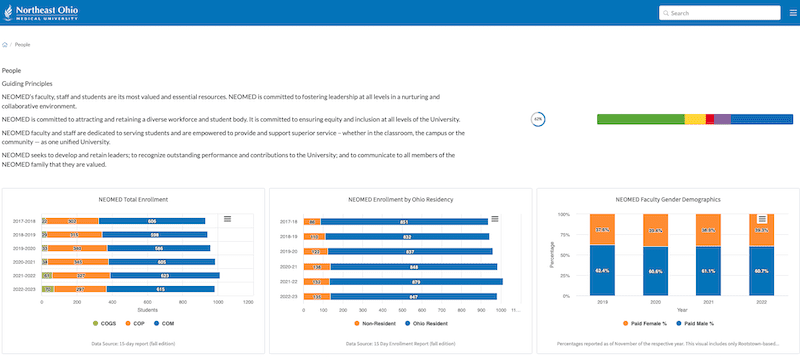Contents
- 1. A strategic plan articulates a shared vision, mission and values
- 2. A strategic plan effectively organizes schools, staff, and time
- 3. A strategic plan defines how success is measured
- 4. A strategic plan helps with decision-making, responsiveness, and innovation
- 5. A strategic plan increases communication and engagement
- 6. A strategic plan keeps everyone in a school—from teachers to administrators—connected
- 7. The best reason of all for strategic planning comes back to every great school’s number one priority: students
- Download the guide ↓
Summary
This blog explains why planning for schools creates clarity, alignment, and stronger outcomes for students. Strategic planning helps schools stay organized, make better decisions, and stay focused on what matters most: student success.
- Schools work more effectively when everyone shares the same vision and values
- Clear plans reduce confusion and help staff manage time and resources
- Defined measures show whether strategies are working
- Planning helps schools adapt quickly during change
- Transparent goals strengthen communication with families and stakeholders
- Alignment across staff increases collaboration and accountability
- A strong plan keeps student needs at the center of every decision
The past three years have been disruptive for every sector. For educational institutions, the impact of the COVID-19 pandemic has impacted everyone–from staff and teachers, to the students who had to switch to a new modality of learning, to the parents supporting them. Strategic planning for schools has revealed itself to be a very important part of recovering. According to the Economic Policy Institute, the COVID-19 pandemic forced nearly 55 million children home in the US alone—and at least 1.4 billion children out of school or child care across the globe. Higher education institutions have been profoundly financially impacted, and both the learning experience and mental wellbeing of the students has been negatively affected.
While every educational institution was impacted by this, some schools were more prepared than others to face the unique challenges COVID-19 posed–those schools who had previously established strategic plans were better prepared to navigate the pandemic than those without.
It’s clear to us: Schools that embrace a great strategic plan, and commit to strategic planning in education, have clear advantages over schools that don’t.
We’re going to talk about some of those advantages now, look at some examples of strategic planning in education, and give 7 reasons for why every school with a vision of excellence for their students should embrace a strategic planning process for schools. Whether it’s getting back on track after a hugely disruptive, global event like COVID-19, identifying the most important strategies to improve student outcomes, or increasing staff engagement, all schools benefit from strategic planning and strategic plan implementation.
The ability for schools to collaborate, share, and communicate short and long term goals is a critical part of moving plans forward in line with a vision, mission, and values. Schools benefit from a well communicated and executed strategic plan that keeps everyone informed of their strategic goals, and how their actions are contributing to the achievement of these goals. This enables parents, staff, community members, and stakeholders to work towards a common vision.
A major additional benefit of strategic planning in education is that it provides an opportunity for active employee engagement across an organization. When it comes to strategic planning for educational institutions, that benefit remains present. Research suggests that a leading cause for employee discontent (in general, but especially in the public sector) is that employees don’t understand how the work they’re doing helps their greater organization.
If the school is able to clearly define and remind employees and stakeholders of the shared vision, employees are more likely to feel connected to the work they are doing within that organization. Whether that work is educating students, organizing reports, performing critical administrative duties, or coordinating the process of standardized testing, everyone plays a part in a student’s success.
2. A strategic plan effectively organizes schools, staff, and time
We understand that schools–whether they are elementary schools, high schools, or higher education institutions– are complex institutions, with boards, committees, districts, unions, and many different types of stakeholders involved. Because the organizations themselves are so large, and plans are often multi-year, complex entities built up by multiple stakeholders and workers, struggles with organization and effective time management are common.
Envisio provides strategic planning software for educational institutions, and because Envisio works exclusively with the public sector, we understand the unique, complex, and often large scale planning needs of public sector organizations.
“I see Envisio very much as a focusing tool as I work with my team. If you’ve got great people, your primary job is not to get in their way […] I can stay on top of performance in a way that is really unobtrusive, and I don’t have to necessarily interact directly with an individual to get a sense of what’s going on. I can stay abreast of the action plans in the communications department or the action plans in a particular school. If we’re missing the mark on a key performance measure, I can focus more time on having the right conversations.”
3. A strategic plan defines how success is measured
In order to achieve success, it’s important to know what success means, and where to take action first. It is difficult to get a strategic action plan underway without a firm understanding of what problems you’re wanting to solve. When it comes to strategic planning in the public sector, determining clear benchmarks for success is especially important, because the goals are often a combination of abstract, impact-based metrics, and concrete, output-based goals.
Different types of educational institutions are going to have different challenges, and different metrics of success: the educational strategic plans of a public school board district are going to look a lot different from a college or university! The shared reality is that every school with a strategy is better able to monitor its progress toward key outcomes and evaluate where and how it may have gotten off track. Using a strategy implementation software like Envisio can help with measuring success.
At Northeast Ohio Medical University (NEOMED), in Portage County, Ohio, they are measuring success across six pillars, with forty two strategic initiatives. Many of their strategic plan elements (goals, strategies, and actions) include promoting diversity, equity, and inclusion for their students, staff, and employees. Being a major medical research university that is training future medical professionals, diversity, equity, and inclusivity is a critical—and practical—metric! Some of the performance measures that NEOMED tracks include gender demographics, and actionable items towards decreasing disability stigma as part of their Strategic Plan: Creating Transformational Leaders Dashboard.

No matter what your benchmark for “success” is—be it a more impact-focused concept such as “be more welcoming” or more concretely articulated in output terms such as “create a low-cost tutoring center using the library after school”, your strategic plan will provide you with the steps to make get that success underway, and stay on track.
4. A strategic plan helps with decision-making, responsiveness, and innovation
A strategic plan helps educational institutions remain agile during times of change, and also helps them better define what they intend to achieve when it comes to their student success objectives and their greater organizational goals. With a strategic plan in place, educational institutions have a roadmap which they can use to track, evaluate, and modify plans to facilitate better governance decisions and provide clearer direction for the future of the school. This helps a school maintain a steady rhythm of progress towards their goals, and remain ahead of the curve–both in terms of educational innovation, and when (not if) a disruptive change occurs.
“It’s difficult, because you’re trying to help students prepare for the future – to prepare for jobs that might not exist yet. You’re trying to develop educators and an education that gives them the skills to think critically.”
White Bear Lake Area School District (WBLAS), MN, was able to leverage their strategic plan as a way to embrace change and turn obstacles (like COVID-19) into opportunities for success. They embraced active learning techniques and, through their strategic plan, were able to think ahead to turn disruptions into teachable moments that engaged students and staff alike.
5. A strategic plan increases communication and engagement
A strategic plan (and particularly, one that is publicly communicated on a dashboard) helps with overall communication and engagement. For a school board, communicating that your plans and your metrics for success are part of a larger, holistic plan, is critical to building trust with stakeholders and maintaining effective engagement—both internally, and externally.
Strategic planning in education is critical in settings where trust is paramount. Educational institutions—at all levels—work on the understanding that one group (the educators) has knowledge they can impart, share, or coax out in another group (the students). The need for a trusting relationship with the students and everyone involved in that student’s success needs to be central to a positive educational environment.
A strategic plan that can be easily found, referenced, and understood helps assure everyone involved that the school in question is aware of their plans, has them in focus, and has a plan for their shortcomings. Educational strategic planning also has the additional benefit of keeping stakeholders—such as donors—excited about the school’s vision. When it comes to fundraising, donors are more likely to support a school that has a clear vision and a strategy to make it happen.
6. A strategic plan keeps everyone in a school—from teachers to administrators—connected
A well implemented and communicated strategic plan holds all staff accountable for their actions and encourages collaboration. In educational settings, this circle of responsibility is extended out towards the community; providing excellent and accessible education is an effort that requires all hands on deck. Being able to simplify the strategic planning process and make it visible and easy to use is one way to ensure everyone stays connected.
One of the benefits of using a strategic planning software partner like Envisio is that individual action plans (from individual schools or departments) can be aligned, all the way up to a greater strategic objective. For multi-year, complex plans, such as setting a national standard of excellence, or incorporating culturally significant teachings—it’s important that teachers and staff are able to understand who is working on what, and where it fits into the greater whole.
7. The best reason of all for strategic planning comes back to every great school’s number one priority: students
Best of all, strategic planning for schools provides a framework so that the most important priority of the school – students’ educational achievement – is taken care of. Having a sturdy educational strategic plan helps keep issues like digital equity, accessibility, literacy, preparation for an ever changing workforce, and social and environmental enrichment, front of mind. When the experience of the student is the priority for the school, the strategic plan becomes a collaborative effort to figure out how best to set students up for success.
Being on the same page for these goals is extremely important for schools: sound planning and communication helps ensure that stakeholders, including parents, teachers, administrators, principals, board members, and the greater community, are all striving for the same overall vision. And, when it comes to putting those plans into action, schools especially benefit from the habit of consistent performance measurement, which is something a strategic plan can help in ingraining.
—
For complex, multi-layered institutions such as an educational institute to successfully reach their goals—particularly after being so dramatically impacted by COVID-19—it requires not only proper management of human, budgetary, and time resources, but the creation of high-output teams, engaged and effective staff and teachers, and the consistent monitoring of progress. For schools, a strategic plan provides a north star for deepening a sense of community and knowledge, and breaks down the actionable steps to reach critical goals.
Download the guide ↓





